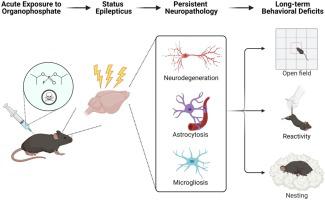NeuroToxicology ( IF 3.4 ) Pub Date : 2021-09-09 , DOI: 10.1016/j.neuro.2021.09.001 Jonas J Calsbeek 1 , Eduardo A González 1 , Donald A Bruun 1 , Michelle A Guignet 1 , Nycole Copping 2 , Mallory E Dawson 1 , Alexandria J Yu 1 , Jeremy A MacMahon 1 , Naomi H Saito 3 , Danielle J Harvey 3 , Jill L Silverman 2 , Pamela J Lein 4

|
Organophosphate (OP) nerve agents and pesticides are a class of neurotoxic compounds that can cause status epilepticus (SE), and death following acute high-dose exposures. While the standard of care for acute OP intoxication (atropine, oxime, and high-dose benzodiazepine) can prevent mortality, survivors of OP poisoning often experience long-term brain damage and cognitive deficits. Preclinical studies of acute OP intoxication have primarily used rat models to identify candidate medical countermeasures. However, the mouse offers the advantage of readily available knockout strains for mechanistic studies of acute and chronic consequences of OP-induced SE. Therefore, the main objective of this study was to determine whether a mouse model of acute diisopropylfluorophosphate (DFP) intoxication would produce acute and chronic neurotoxicity similar to that observed in rat models and humans following acute OP intoxication. Adult male C57BL/6J mice injected with DFP (9.5 mg/kg, s.c.) followed 1 min later with atropine sulfate (0.1 mg/kg, i.m.) and 2-pralidoxime (25 mg/kg, i.m.) developed behavioral and electrographic signs of SE within minutes that continued for at least 4 h. Acetylcholinesterase inhibition persisted for at least 3 d in the blood and 14 d in the brain of DFP mice relative to vehicle (VEH) controls. Immunohistochemical analyses revealed significant neurodegeneration and neuroinflammation in multiple brain regions at 1, 7, and 28 d post-exposure in the brains of DFP mice relative to VEH controls. Deficits in locomotor and home-cage behavior were observed in DFP mice at 28 d post-exposure. These findings demonstrate that this mouse model replicates many of the outcomes observed in rats and humans acutely intoxicated with OPs, suggesting the feasibility of using this model for mechanistic studies and therapeutic screening.
中文翻译:

氟磷酸二异丙酯急性中毒致癫痫持续状态小鼠模型的持续神经病理学和行为缺陷
有机磷 (OP) 神经毒剂和杀虫剂是一类可引起癫痫持续状态的神经毒性化合物(SE),以及急性高剂量暴露后的死亡。虽然急性 OP 中毒的护理标准(阿托品、肟和大剂量苯二氮卓类药物)可以预防死亡,但 OP 中毒的幸存者经常会出现长期脑损伤和认知缺陷。急性 OP 中毒的临床前研究主要使用大鼠模型来确定候选的医学对策。然而,小鼠提供了易于获得的敲除菌株的优势,用于 OP 诱导的 SE 的急性和慢性后果的机制研究。因此,本研究的主要目的是确定急性二异丙基氟磷酸 (DFP) 中毒的小鼠模型是否会产生类似于在急性 OP 中毒后在大鼠模型和人类中观察到的急性和慢性神经毒性。注射 DFP 的成年雄性 C57BL/6J 小鼠 (9. 5 mg/kg, sc) 1 分钟后,硫酸阿托品 (0.1 mg/kg, im) 和 2-解磷定 (25 mg/kg, im) 在几分钟内出现 SE 的行为和电图迹象,持续至少 4 小时. 相对于载体 (VEH) 对照,乙酰胆碱酯酶抑制在 DFP 小鼠的血液中持续至少 3 天,在大脑中持续 14 天。免疫组织化学分析显示,与 VEH 对照相比,DFP 小鼠大脑中暴露后 1、7 和 28 天的多个大脑区域存在显着的神经变性和神经炎症。在暴露后 28 天,在 DFP 小鼠中观察到运动和家庭笼子行为的缺陷。这些发现表明,这种小鼠模型复制了在急性中毒 OPs 的大鼠和人类中观察到的许多结果,



























 京公网安备 11010802027423号
京公网安备 11010802027423号